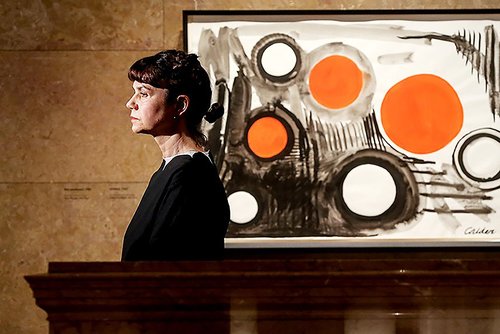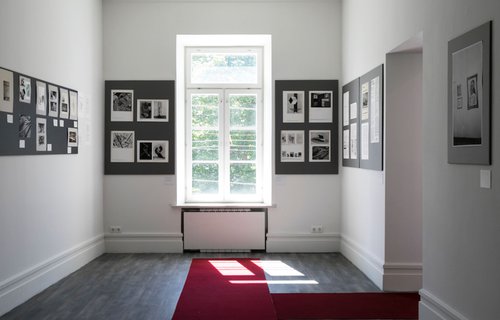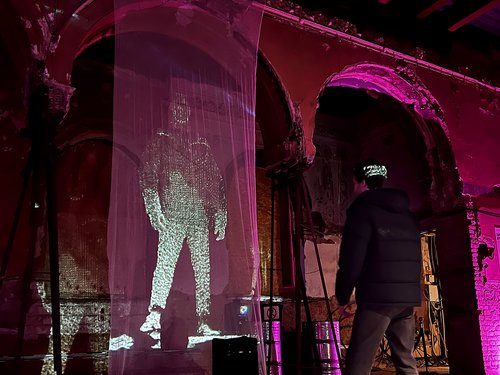Ups and Downs of Remote Curating and Artistic Production

Hidden. Exhibition view. St Petersburg, 2024. Photo by Elena Pchelnikova. Courtesy of Third Place press office
Once an unusual practice, remote curating has become increasingly common due to major global challenges like the global pandemic and political conflicts. Today artists and curators are adapting to working across borders, using technology to nurture and maintain creative collaborations despite all the logistical hurdles.
As Viktor Misiano, a prominent Russian art theorist and curator recalls, in 2007 he was forced by circumstances to work on an exhibition remotely. It was ‘Return of the Memory’ which was part of a project called ‘Progressive Nostalgia’ at Tallinn's KUMU Museum and “due to a diplomatic conflict, the consulate was closed, and I didn't get a visa,” he recalls. “I did the exhibition via Skype. But I knew the space well, and we did a great job”. However, even today for Misiano remote work on exhibitions is still very much alien to his own curatorial attitude.
Yet almost two decades remote curating or the remote creation of an art exhibition is no longer shocking. It all started with the global pandemic and lockdown. IRL interactions between people became minimal and most of humanity had to communicate by Zoom or messengers. Two years later, other circumstances played their hand: wars, emigration, and borders which have become increasingly less surmountable. Many Russian artists and curators live outside their homeland, and some of them continue to create or take part in exhibitions there.
In December 2022, Alexander Plusnin's (b. 1981) solo exhibition ‘World without Humanity is of no Interest to Me’ opened at the Vadim Sidur Museum in Moscow, a branch of Moscow Museum of Modern Art. By this time, he had been living outside Russia for several months. Plusnin had experience of working remotely in the IT sphere, so he saw no problem in realising the long-planned exhibition remotely: “If you have already been in the place before, you already have a physical sense of the space. And then come the visualisation and formulation of tasks involved in putting it all together.” The artist remembers the difficulties in working with the production manager, who did not closely follow his for the installation and chose materials that were not always suitable. “It was the first time we had worked together, and we had only met once or twice before that,” said Plusnin, “so we just spoke different languages. It is much easier when you know each other well and the other person is familiar with your background, aesthetics and language.” In contrast, Plusnin had known the director of the museum and PR director for a long time, and working with them remotely was a productive experience.
Artur Golyakov (b. 1991), an artist living in Kazan and member of the art collective ‘Plague’, talks about his first experience of mounting an exhibition abroad, which was also remote: “In 2019, the Italian artist Mirko Canesi asked us to do something for Edicola Radetzky, an exhibition space in the centre of Milan, in a former newsstand kiosk. We had a very tight deadline and a small budget, we did not have time to make and send the work and together with Vitaly Bezpalov, who had been invited to take part, so we decided to simplify the production. We asked Mirko to put glue on black film and sprinkle it with soil for household plants, put prints with the works of the participants on the windows, and use this film as a background for them. There is no way for spectators to enter the kiosk, it has windows on all four sides – the impression was that it was completely filled with soil”.
In March 2023, Golyakov remotely made a solo exhibition in Canesi's studio in Brussels: “I sent him folded cardboard boxes with my works on paper. He assembled them and hung them on the walls according to my instructions. The boxes were chosen as a material that allowed to circumvent logistical and customs difficulties.” In December of the same year, Golyakov, along with Turkish artist Bora Akinciturk (b. 1982), put together the exhibition ‘The Artist’ at Moscow's másla lissé gallery. Akinciturk himself could not come to Russia, so Golyakov made a series of paintings about the difficult fate of an aspiring artist under his supervision. The artist signed them remotely, and later they were sent to him in London by complicated means. It is fascinating: Golyakov and Akinciturk have been collaborating for a long time but have never met one another in real life.
Ambitious art projects are now often supervised remotely too. For example, Anna Zhurba, who lives in Buenos Aires, has created two group exhibitions remotely, ‘The Great Emptiness’, which took place at the Ruarts Foundation in Moscow, and ‘Hidden’, currently on view at the Third Place in St Petersburg. An employee of a leading Russian institution now living abroad who shared her experience of remote curating on condition of anonymity – let us call her for simplicity's sake Ekaterina Lebedeva - has also put together several projects in Russia.
‘Lebedeva’ believes that time zone differences does not hinder her; she has been working and collaborating with artists from different time zones for many years. “Working remotely inevitably slows down the decision-making process,” Lebedeva reflects, “which requires more careful planning and coordination, something many of us learnt during the pandemic. But it also forces you to be more deliberate in your approach to projects.W Zhurba, based in Buenos Aires, has a six-hour difference from Moscow: “It is convenient: one part of the day overlaps with working hours in Russia, and the other part of the day is quiet, so you can do things that require silence. But in general, self-discipline and goal setting are important. Besides, the downsides of remote work have been compensated for by my own new experience of motherhood. It teaches you to prioritise, not to procrastinate, and is ideal from the point of view of time management. But I liked working from home in Moscow too, when I had the opportunity.”
Anna Zhurba had only one experience of remote installation in the Great Emptiness project. “The Ruarts Foundation is a contemporary, well-equipped space, essentially a white cube,” Zhurba recalls, “so curating the installation remotely there was not such an intimidating prospect. But of course, it is better to be at the installation. At ‘The Third Place’ a complicated space in an abandonned 19th century mansion house, abandoned for many years, working remotely is impossible. I was responsible for much of the exhibition ‘Hidden’ on a remote basus but in the end I had to come to the site.” Zhurba jokes that although video communication is, of course, a great achievement she feels more confident working with plans and photographs of a space. “If you cannot fly in, there are two options left,” concludes ‘Lebedeva’. “Either you have a co-curator on site to supervise the process or online involvement in the process, but this is only possible with a highly professional team and producers who know the exhibition plan and the technical nuances of the space”.
‘Lebedeva’ admits that today communication with artists often starts with sending a proposal for co-operation via social media, more often Telegram or Instagram. “A face-to-face meeting is preferable, it helps to understand how much you can work together,” Lebedeva notes. “But this is not always possible. Often my own face-to-face meetings with an artist are during the installation process if at all. After studying the portfolio and looking at areas of co-operation, I hold several online meetings with the artists. At this stage it is particularly important to create together a clear understanding of the context of the project and the characteristics of the site, so that the artists can assess in advance the difficulties of realisation and the potential of the collaboration. Through such conversations, you assess the local context of the project. After all, the most difficult stage is to reach a mutual understanding of why and for whom we are doing the show. It is especially difficult to answer these questions now.”
To curate an exhibition, you need to understand the local context. That is why Anna Zhurba tries to follow the news from Russia: “Of course, I miss some things, but there is an exchange of impressions with friends and colleagues, but certainly I miss the important stuff that does not get onto social networks and Telegram feeds. But powerful projects get to you one way or another, while the process for the sake of the process passes you by. This filter seems to work better from a distance.” Zhurba notes that by immersing herself in other contexts, she has begun to understand more about her own original context: “Last year I went to the São Paulo Biennale for the first time and saw in contrast how much freedom of artistic expression has dissolved in the Russian context”. After two years of absence from the country ‘Lebedeva’ feels a disconnect with the local context, as assimilation in a different cultural environment takes place and information about Russia comes through a limited number of channels. “This process is inevitable,” she laments. “Every year it becomes more and more difficult to follow Russian processes, in particular because of the state's growing desire for information isolation. But paradoxically, remote observation provides a unique opportunity to look at the situation from a broader perspective. Being inside the context, it is difficult to maintain objectivity, while an outside perspective allows us to see the dynamics of the processes more clearly.”
‘Lebedeva’ reflects on the challenges of curating: “As Anatoly Osmolovsky (declared a foreign agent by the Russian authorities - Ed.) pointed out in a recent interview, contemporary art no longer fulfils the task of strengthening international communication and improving the image of Russia. However, many institutions continue to work inertly in the old paradigm, simply changing recipients”. In the face of archaisation, it is unclear what art has to offer. “For myself, I have developed two key principles,” summarises ‘Lebedeva’. “Firstly, I will not work with a certain range of themes and artists as a matter of principle. Secondly, I am searching more intuitively, ‘manually’ for micro-contexts that resist existential and informational isolation. The window of opportunity is getting narrower, but this approach allows me to find themes that remain relevant and resist the archaisation of cultural production.”
Anna Zhurba feels deeply immersed in the local context: “My interest in Russian art has never been as high as it has been in the last two years. There is a lot to talk about now, searching for a language, an approach, a connection with the audience and mutual support. However, the reverse process of complete escapism is also noticeable. That is why you do not choose the themes for exhibitions now; life itself suggests them”. Zhurba fears the growth of misunderstanding and alienation between those who have left the country and those who have stayed. She considers it extremely important to counteract this in every conceivable way. “So, the main theme for me now,” concludes Zhurba, “is a productive dialogue between colleagues, artists and viewers.”


















